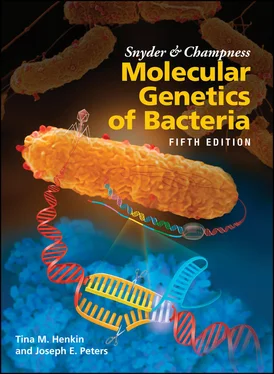There are other DNA sequences that are not polar but that show biases for regions of the chromosome. Around the origin of B. subtilis , an area recognized by the Spo0J protein for segregation of the origin region to daughter cells, the parS sequence, is found 8 times (the orange rectangular boxes in the figure). Also around the origin of B. subtilis , there is an enrichment of ram sites (short yellow dashes), a sequence recognized by the RacA protein for maintaining segregation during sporulation. Binding sites for the nucleoid occlusion proteins which prevent septum formation until division is nearly complete reside across the chromosome but are absent from the terminus region. SlmA-binding sites (SBS) in E. coli and Noc-binding sites (NBS) in B. subtilis (long brown dashes) are recognized by SlmA and Noc, respectively. The GATC sites (not shown), which are important for regulating the initiation of DNA replication at oriC in E. coli , also show enrichment in the oriC region, with a spacing that is important for SeqA binding. The organization of the large domain comprising the terminus region of the chromosome appears to be important in E. coli , where the MatP protein recognizes matS sites (red dashes in the E. coli diagram) found across this region.
Blattner FR, Plunkett G III, Bloch CA, Perna NT, Burland V, Riley M, Collado-Vides J, Glasner JD, Rode CK, Mayhew GF, Gregor J, Davis NW, Kirkpatrick HA, Goeden MA, Rose DJ, Mau B, Shao Y.1997. The complete genome sequence of Escherichia coli K-12. Science 277:1453–1462.
Touzain F, Petit M-A, Schbath S, El Karoui M.2011. DNA motifs that sculpt the bacterial chromosome. Nat Rev Microbiol 9:15–26.
While bacteria do not contain a special membrane compartment for chromosomal DNA like the nucleus of eukaryotes, even in bacteria the chromosome does not freely diffuse within the cytoplasm. In fact, as we learn more about bacterial chromosomes, we are realizing that they are maintained with an incredible amount of organization. Even with the aid of only a standard laboratory microscope and DNA stain, a mass of chromosomal DNA is easily observed in the center of the cell in a structure called the nucleoid, which is very compact, considering that the DNA is about a thousand times as long as the cell.
Because of the large size of the chromosome, the process of moving the replicating chromosomes to daughter cells, called segregation, is not trivial. Chromosome segregation encounters a number of obstacles. Obvious initial obstacles are viscous forces and torsional stress associated with unwinding the template strands of DNA. Advances in microscopy and techniques that allow the localization of certain regions of the chromosome are revealing the choreography involved in coordinating DNA replication and chromosome segregation. Microscopy experiments using green fluorescent protein (GFP) fused to replication proteins allow the localization of DNA replication forks, and GFP fused to proteins that bind to specific sites on DNA allows localization of the origin and terminus in the cell. These experiments show that soon after the initiation of DNA replication within the nucleoid, the origins start to move to the daughter cells. Once replication is complete, segregation would still be prevented if daughter chromosomes were joined by recombination, interlinked, or otherwise tangled during replication. Even if they were not physically joined, their separation would be very difficult if the two daughter chromosomes were randomly spread out throughout the cell. It is therefore not surprising that bacteria have a number of systems to ensure that their chromosomes segregate properly into the daughter cells during cell division. Molecular systems responsible for chromosome segregation are discussed separately below.
RESOLUTION OF DIMER CHROMOSOMES
During the process of DNA replication, two circular daughter chromosomes will periodically become joined, forming a chromosome dimer, in which they are joined end to end to form a double-length circle. Dimer chromosomes can result from recombination between the two replicating chromosomes and are fairly common. Recombination involved in restarting stalled DNA replication forks from a sister chromosome probably accounts for many of these events (see chapter 9). Such dimers prevent chromosome segregation because the two daughter chromosomes are part of the same large molecule.
If dimer chromosomes can be created by recombination, they can also be resolved into the individual chromosomes by a second recombination event. The general recombination system could in theory resolve the dimers between sister chromosomes by recombination; however, the general recombination system can both create and resolve dimers, depending on how many crossovers occur between the daughter DNAs. An odd number of crossovers occurring between any two sequences on the two daughter DNAs in the dimer will resolve the dimer, but an even number of crossovers will recreate a dimer.
All bacteria with a circular chromosome appear to have a system dedicated to dimer resolution. In E. coli , and in most bacteria, the so-called Xer recombination system is used to resolve chromosome dimers. Rather than using the general recombination system, the Xer systems involve a site-specific recombinase (see chapter 8) to resolve chromosome dimers. This system has evolved so that it resolves dimers into the individual chromosomes but does not create new dimers. Its action is also coordinated with division of the cell and other important chromosome-partitioning functions. The Xer recombination system consists of two proteins called XerC and XerD and a specific site in the chromosome called dif . If two copies of the dif site occur on the same DNA, as happens when the chromosome has formed a dimer, the Xer proteins promote recombination between the two dif sites, resolving the dimer into the individual chromosomes ( Figure 1.17). The dif site is always found centrally located in the ter region in bacterial chromosomes. This is likely, in part, to help ensure that there is only one dif site in the cell until just before cell division so that it is not replicated until just before the chromosome has completed replication and just before the cell divides. As added insurance, the activity of the Xer site-specific recombination system is also dependent on the formation of the division septum through an interaction with the FtsK protein. As diagrammed in Figure 1.17, FtsK protein is localized to the region where the division septum pinches in during cell division, where it plays multiple roles, including facilitating dimer resolution. While the Xer proteins are needed for dimer resolution, they are actually active for full dimer resolution only when they interact with FtsK. As shown in Figure 1.17, the localization of FtsK at the septum limits the dimer resolution process temporally and spatially to when the daughter chromosomes are in the process of moving through the septum into daughter cells, a process that is facilitated and coordinated by FtsK itself (see below) (see Aussel et al., Suggested Reading).
The FtsK protein is a DNA translocase that can pump DNA through itself to help align the two dif sites in a dimer chromosomal DNA at the septum in the middle of the cell before they recombine, thereby facilitating segregation into daughter cells ( Figure 1.17). See the reconstructed image of the structure of the motor domain of FtsK at the start of this chapter (see also Jean et al., Suggested Reading). An obvious question is how the FtsK protein “knows” which direction pumps to engage for transporting DNA in the correct direction to move a dif site to the septum. It does this by using sites on the DNA as an orientation cue. These sites are called the KOPS sites, for FtsK-orienting polar s equence. Polar means that they read differently in one direction on the DNA than in the other. These sequences are oriented in the DNA so that they will only be read progressing from the origin to the dif site in the chromosome; the FtsK protein, by translocating the DNA in the direction pointed to by the KOPS sites, will pump the DNA toward the dif sites close to the terminus of replication. Note in Figure 1.17how the polar KOPS sites in the chromosome (shown as half-arrows) can be used as directional information by FtsK to mobilize the chromosome to the daughter cells while moving the dif sites toward the septum. This is just one example of how the chromosome, typically thought of as the informational storehouse of the cell, also contains structural information used by the many proteins that manage and repair the chromosome ( Box 1.1). FtsK also has a domain that interacts with topoisomerase IV, a protein capable of untangling catenanes in the chromosomes (see below). Therefore, the FtsK protein coordinates a veritable clearinghouse of activities that help with chromosome management during chromosome replication and chromosome segregation.
Читать дальше











